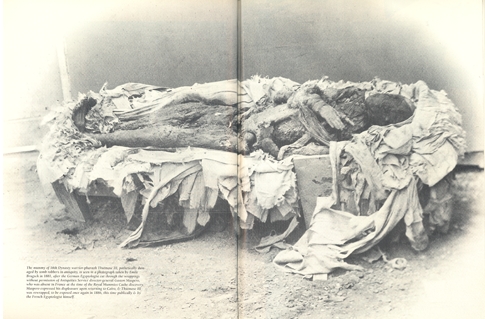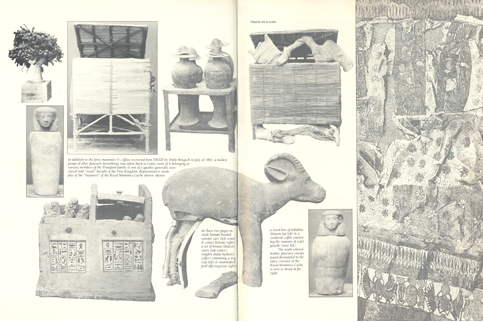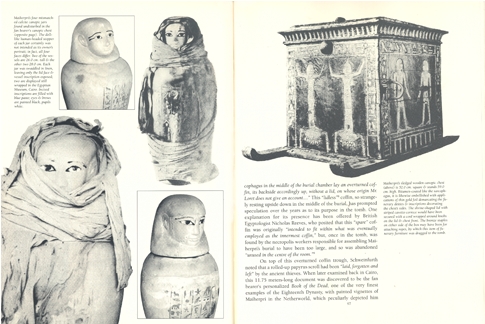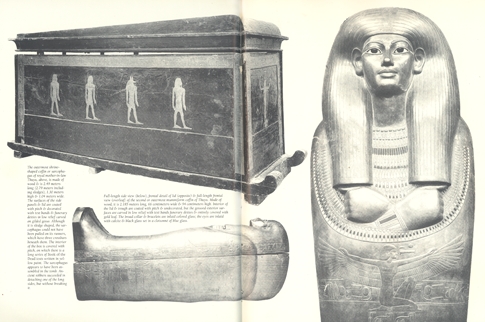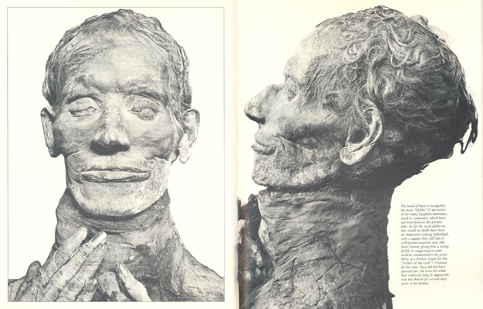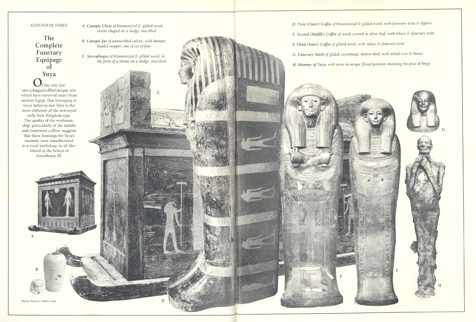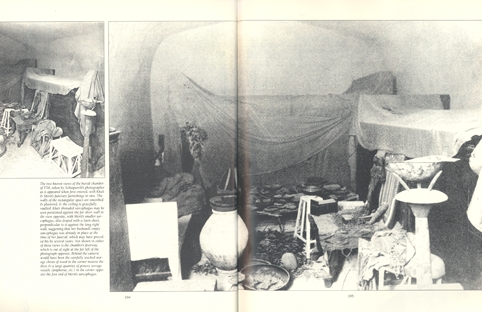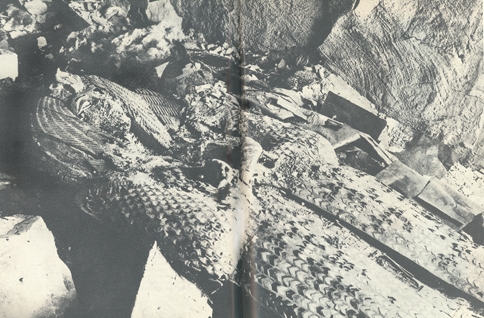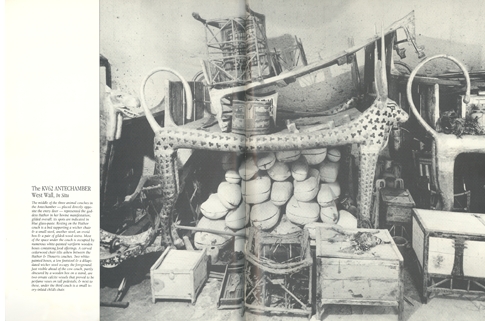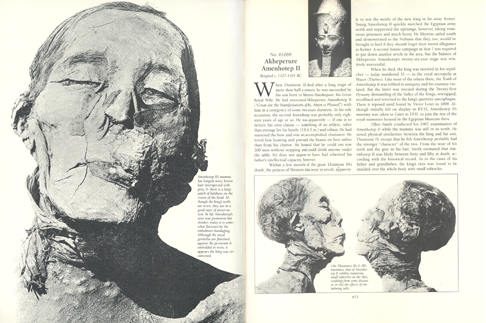TOMBS.TREASURES.MUMMIES:
Seven Great Discoveries of Egyptian Archaeology
by Dennis C. Forbes
The ancient Egyptian culture —
perhaps more than any other civilization of antiquity or even
modern times — put a great deal of emphasis on
preparation for existence in the Hereafter. Because the Nile
dwellers of the dynastic period ex-pected to continue their
mortality in the next life very much as they had experienced it
in the earthly sphere, they placed in their tombs everyday
objects which were important to them & would be requisite
in their otherworldly future, as well as a whole panapoly of
magical equipment which would insure their safe passage into
that Afterlife. Because of the sheer numbers of such tombs so
provisioned, & the generally arid climate of Egypt itself,
a great many of these ancient Egyptian burials have survived
to the preset era — al- beit the majority of them
were robbed to some degree (totally or only partially) in
antiquity or more recently.
The present
work looks in detail at seven of these tombs, ranging from an
Eighteenth Dynasty royal sepulcher (the Tomb of Amenhotep II)
which was vastly plundered in ancient times, then reused to
cache the rescued mummies of several New Kingdom rulers; to the
burial of a high-status commoner couple (Kha & Merit) which
was found to be absolutely unviolated when discovered in 1906;
to the robbed but essentially intact interment of an obscure
boy-king, whose mummy was, nonetheless, nested in a series of
gilded tabernacles & coffins, the incredible innermost one
of which was found to be made of solid gold: the world-famous
Tomb of Tutankhamen.
The stories of
the discoveries of the seven tombs included herein trace, to
some degree, the evolution of archaeology in modern-era Egypt.
The first site discussed, the Royal Mummies Cache (DB320), was
discovered accidentally in 1871, by fellahin tomb robbers who
subsequently began to plunder it secretly; when the
tomb’s existence was made known to Egyptian Antiquities
authorities a decade later, it was hastily cleared by the
latter, with no concern except to remove as quickly as possible
its thirty-five mummified occupants & a few accompanying
funerary objects, all to the safety of the state museum in
Cairo. The next two discoveries discussed, Valley of the Kings
tombs 35 & 36, while cleared with some degree of care, were
never formally published. The famous Tomb of Yuya & Thuyu
(KV46) & the controversial so-called “Amarna
Cache” (KV55) were found under the auspices of American
dilettante treasure-seeker Theodore M. Davis, & both were
minimally recorded, hastily cleared & inadequately
published, leaving many archaeological questions unanswered to
this day. Finally, however, by the time the Tomb of Tutankhamen
was discovered in 1922, the state
of archaeology in Egypt had reached full maturity & the
eight years spent clearing that amazing site of its exquisite
contants represent the ultimate in scientific recording &
conservation of precious relics which have managed to survive
from antiquity.
In addition to
the seven chapters telling the stories of the individual tombs
discussed, the present work also includes two complete
catalogues (appendices 2 & 3) of the famous Royal Mummies
of ancient Egypt.
(from the dust jacket)
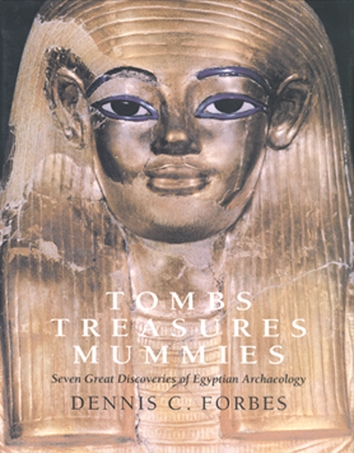
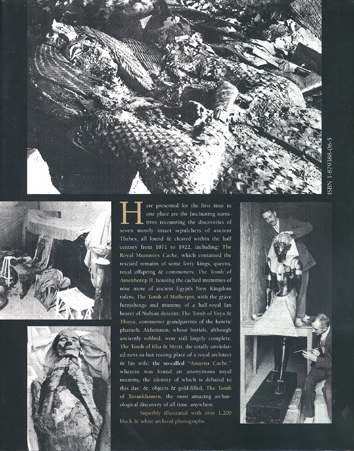
Back of dust jacket
TABLE OF CONTENTS
FOREWORD
CHAPTER ONE
The Royal Mummies Cache
Tomb DB320 at Deir el Bahari South, 1881
CHAPTER TWO
The Second Royal Mummies Cache
KV35, The Tomb of Amenhotep II, 1898
CHAPTER THREE
The Tomb of Maiherpri
No. 36 in the Valley of the Kings, 1899
Addendum One
Daressey’s Account of the Unwrapping
of Maiherpri’s Mummy
Addendum Two
Maiherpri’s Gazelle-Skin Loincloths
Addendum Three
Inventory of Objects from the
Tomb of Maiherpri
CHAPTER FOUR
The Tomb of Yuya & Thuyu
No. 46 in the Valley of the Kings, 1905
Addendum One
The Mummy of Yuya
Addendum Two
The Mummy of Thuyu
Addendum Three
The Complete Funerary Equipage of Yuya
Addendum Four
The Complete Funerary Equipage of Thuyu
Addendum Five
Papyrus of Yuya
Addendum Six
Inventory of Objects from the
Tomb of Yuya & Thuyu
CHAPTER FIVE
The Tomb of Kha & Merit
TT8 at Deir el Medina, 1906
Addendum
The X-Rayed Mummies of Kha & Merit
CHAPTER SIX
The So-Called “Amarna
Cache”
Tomb 55 in the Valley of the Kings, 1907
Addendum
The Problematic “Mummy” of
KV55
CHAPTER SEVEN
The Tomb of Tutankhamen
No. 62 in the Valley of the Kings, 1922
Addendum One
The Chronology of the Tomb of Tutankhamen
& Its Discovery
Addendum Two
“Pharaoh’s Curse”
Addendum Three
The Complete Funerary Equipage
of Tutankhamen
APPENDIX ONE
Locations, Architecture & Situations
of the Tombs
APPENDIX TWO
Catalogue of the Mummies from DB320
APPENDIX THREE
Catalogue of the Mummies from KV35
Addendum
Royal Mummies Musical Chairs:
Cases of Mistaken Identities
APPENDIX FOUR
Abusing Pharaoh: Mistreatment of
the Mummy of Tutankhamen
in Antiquity & Modern Times
Addendum
How Did Tutankhamen Die?
ABOUT THE AUTHOR
An ardent Egyptophile since his childhood,
Tombs.Treasures.Mummies. author
Dennis C. Forbes created the quarterly Kmt, A Modern Journal of Ancient Egypt in 1990 & continues to this day as its
editorial director, having contributed numerous articles,
photographs & graphics to the journal dur- ing the years
since its inception. He is also the author of Imperial Lives: Illustrated Biographies of
Significant New Kingdom Egyptians, Vol. One, The Eighteenth
Dynasty through Thutmose IV.
Volume Two is in preparation.
LIMITED QUANTITY AVAILABLE
|
|
||||||||||||
|
TO ORDER CLICK BELOW
|
|
|||||||||||
|
|
||||||||||||
|
U.S. Residents $89.95
(includes s/h)
All Foreign US$119.95
(includes airmail shipping)
|
|
|
||||||||||
|
|
||||||||||||
|
>
|
|
|||||||||||
|
|
||||||||||||
|
>
|
|
|||||||||||
|
|
||||||||||||
|
|
||||||||||||
|
>
|
|
|||||||||||
|
|
||||||||||||
|
|
||||||||||||
|
>
|
|
|||||||||||
|
|
||||||||||||
|
|
|
|
|
|
|
|
|
|
|
|
|
|
Hardcover, 8.5 x 11”, 732 pages, over
1,250 b/w archival illustrations
